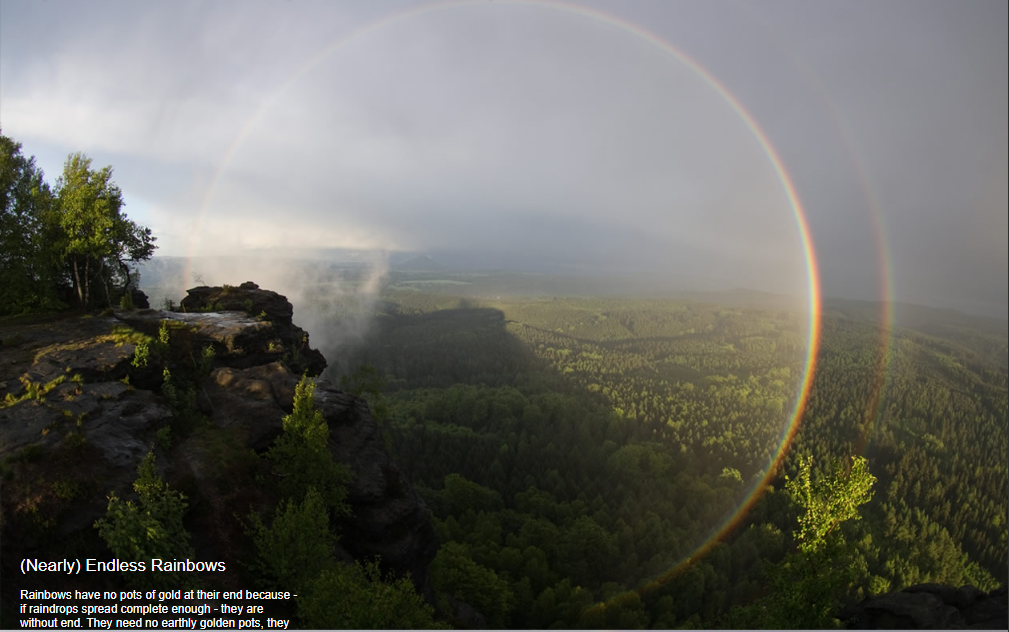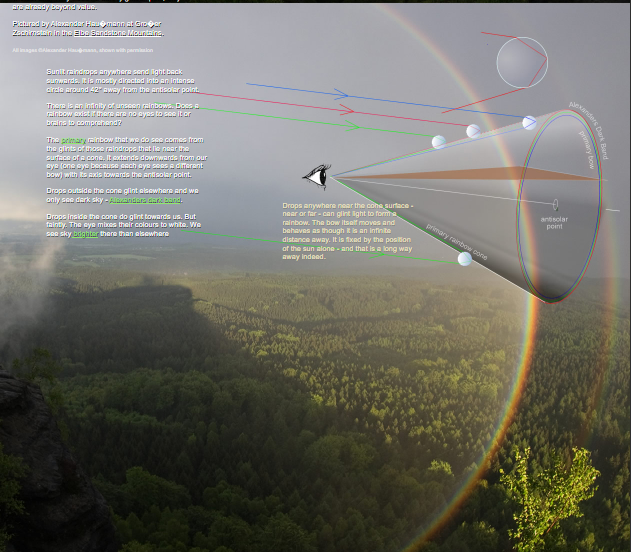Nearly Endless Rainbows - OPOD
Nearly Endless Rainbows - Exploring the Phenomenon
Rainbows have captivated humans for centuries with their vibrant colors and ethereal beauty. While the traditional folklore suggests that rainbows lead to pots of gold, the true magic lies in the fact that these optical wonders are without end. In this article, we will delve deeper into the fascinating world of rainbows, uncovering the science behind their formation and the infinite possibilities they present.
When sunlight passes through raindrops, it undergoes a process known as refraction, where the light bends and separates into its constituent colors. These colors then reflect internally within the raindrop before exiting and forming a rainbow. While we often observe a single primary rainbow, there is actually an infinity of unseen rainbows surrounding us. But do these rainbows exist if there are no eyes to see them or brains to comprehend their beauty?
The primary rainbow that we do see is a result of the glints of raindrops located near the surface of a cone. This cone extends downwards from our eye, with its axis directed towards the antisolar point, which is approximately 42° away from the sun. Drops outside this cone glint elsewhere, resulting in what is known as Alexander's dark band, where we only perceive a dark sky.
Inside the cone, drops glint towards us, although faintly. As our eyes perceive these glints, they mix the colors to create white. This phenomenon explains why we observe a brighter sky within the cone compared to other areas. It's important to note that drops anywhere near the cone surface, regardless of their proximity, have the potential to glint light and form a rainbow.
One remarkable aspect of rainbows is their seemingly infinite distance. The bow itself behaves as though it is an infinite distance away, fixed solely by the position of the sun. This illusion is due to the fact that rainbows are formed by countless raindrops at varying distances from the observer. As a result, rainbows appear to be a magical portal to another world, stretching far beyond our reach.
To truly appreciate the beauty of rainbows, it is essential to understand their optical properties. Each color in a rainbow corresponds to a specific wavelength of light, with red having the longest wavelength and violet the shortest. As sunlight passes through raindrops, it undergoes dispersion, causing the separation of these colors. This dispersion gives rise to the distinct banding effect we observe in rainbows, with red on the outer edge and violet on the inner edge.
In addition to traditional rainbows, there are various other atmospheric phenomena that result in similar optical displays. These include double rainbows, supernumerary rainbows, and even lunar rainbows, which occur when moonlight interacts with raindrops. Each of these phenomena offers a unique perspective on the interaction between light and water droplets, further enriching our understanding of atmospheric optics.
In conclusion, rainbows are not only a stunning display of nature's beauty but also a testament to the fascinating interplay between light and water droplets. Their seemingly endless nature and vibrant colors continue to captivate and inspire us. Whether we gaze at a single primary rainbow or witness the magic of a double rainbow, each experience serves as a reminder of the wondrous mysteries that surround us in the natural world. So next time you spot a rainbow gracing the sky, take a moment to marvel at its splendor and appreciate the infinite possibilities it represents.

(Nearly) Endless Rainbows
Rainbows have no pots of gold at their end because - if raindrops spread complete enough - they are without end. They need no earthly golden pots, they are already beyond value.
Pictured by Alexander Hau�mann at Gro�er Zschirnstein in the Elbe Sandstone Mountains.
All images ©Alexander Hau�mann, shown with permission

Sunlit raindrops anywhere send light back sunwards. It is mostly directed into an intense circle around 42° away from the antisolar point.
There is an infinity of unseen rainbows. Does a rainbow exist if there are no eyes to see it or brains to comprehend?
The primary rainbow that we do see comes from the glints of those raindrops that lie near the surface of a cone. It extends downwards from our eye (one eye because each eye sees a different bow) with its axis towards the antisolar point.
Drops outside the cone glint elsewhere and we only see dark sky - Alexanders dark band.
Drops inside the cone do glint towards us. But faintly. The eye mixes their colours to white. We see sky brighter there than elsewhere
Drops anywhere near the cone surface. near or far-can glint light to forme rainbow. The bow itself moves and behaves as though it is an infinite distance away. It is fixed by the position of the sun alone and that is a long way away indeed.
Note: this article has been automatically converted from the old site and may not appear as intended. You can find the original article here.
Reference Atmospheric Optics
If you use any of the definitions, information, or data presented on Atmospheric Optics, please copy the link or reference below to properly credit us as the reference source. Thank you!
-
<a href="https://atoptics.co.uk/blog/nearly-endless-rainbows-opod/">Nearly Endless Rainbows - OPOD</a>
-
"Nearly Endless Rainbows - OPOD". Atmospheric Optics. Accessed on November 26, 2024. https://atoptics.co.uk/blog/nearly-endless-rainbows-opod/.
-
"Nearly Endless Rainbows - OPOD". Atmospheric Optics, https://atoptics.co.uk/blog/nearly-endless-rainbows-opod/. Accessed 26 November, 2024
-
Nearly Endless Rainbows - OPOD. Atmospheric Optics. Retrieved from https://atoptics.co.uk/blog/nearly-endless-rainbows-opod/.